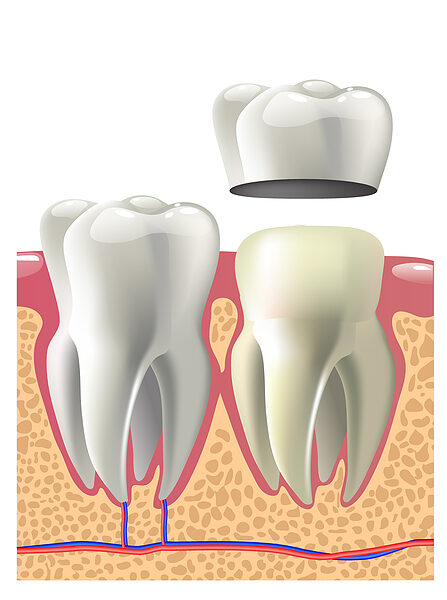Dental crowns, also known as dental tooth caps, are used to restore functionality to decayed or otherwise damaged teeth. The procedure to fit dental crowns is explained in detail below.
The dental crown procedure: explained

The process for dental crown (also known as a tooth cap) procedure is relatively straightforward, with the procedure itself lasting between one to two hours.
In your first initial visit, your dentist will take an X-ray of your mouth and jawbone to identify any problems, such as tooth decay, breaks in the tooth and more. If the X-ray shows signs that the pulp is infected, you may require a root canal procedure before you are able to undergo a dental procedure.
Next, your tooth is shaped to ensure the crown fits properly onto the affected tooth. An ill-fitting crown can cause further problems down the line, such as an uneven bite, jaw pain and risks of infection due to food and drink getting caught in the gaps. You and your dentist will decide on the type of crown you have placed (this is covered in more detail on our types of dental crown article). Once your crown type has been chosen and all (if any) remaining tooth decay has been removed, your implant process can begin.
If you do have noticeable decay
In some cases, the tooth decay may have damaged the tooth so badly that its foundations won’t be able to support the crown. This may require a filling to help support the remainder of the tooth to ensure the crown fits properly later on.
When your affected tooth has been filled and/or properly shaped for crown placement, your dentist will then create an impression of your tooth. This is so that they can create a crown that perfectly sits atop the tooth. Your dentist may also take an impression of the opposing tooth on the opposite side of your jaw. This is to ensure your bite matches up correctly.
How are dental crown impressions made?
Your dentist will use a putty-based material to create your crown impression. This material is spread across the tooth area and then removed, leaving the tooth impression in the putty. Your dentist will then ensure they have all the necessary details of your tooth to create a crown that will be installed correctly and also look aesthetically-pleasing.
The final step is to place a temporary crown over the affected tooth. The temporary crown should only be left on for approximately 2-4 weeks to allow enough time for your dentist to create the permanent crown.
After your temporary crown has been removed
Once your permanent crown has been created, your dentist will remove your temporary crown and install your new, permanent crown. A local anaesthetic will be applied to your gum so you feel no pain as the crown is installed. Your dentist will then ensure that your crown fits correctly and the colour matches your surrounding teeth (unless you have opted for a metal-based crown, such as stainless steel). If the crown does not fit properly, your dentist will make some small adjustments to ensure your crown feels comfortable.
After you are happy with your crown and your dentist has completed any necessary final adjustments, you will be able to leave the clinic.
Do you need a dental tooth crown?
If you notice your tooth has signs of decay, or you have recently injured your tooth (causing breaks, chips, cracks etc), then you may be a candidate for a dental crown. If any of the above reasons are appropriate to your tooth condition, you should arrange a checkup with your dentist to ensure the tooth can be repaired. Leaving the damaged tooth can lead to bacteria and decay forming, which could leave you requiring a root canal procedure.
Book your checkup at Hove Dental Clinic today to receive the treatment you need.




















